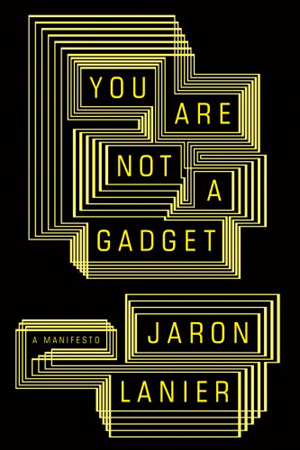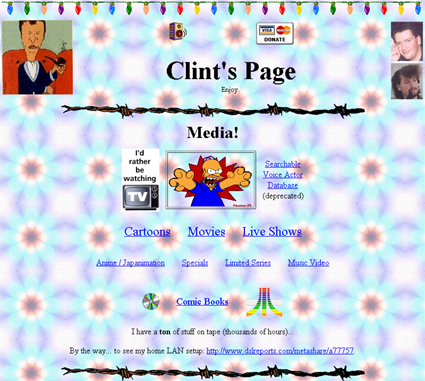
You Are Not a Gadget: A Manifesto
When developers of digital technologies design a program that requires you to interact with a computer as if it were a person, they ask you to accept in some corner of your brain that you might also be conceived of as a program. When they design an internet service that is edited by a vast anonymous crowd, they are suggesting that a random crowd of humans is an organism with a legitimate point of view. – Jaron Lanier
Jaron Lanier’s You Are Not a Gadget is a book that has infuriated the Information Age idealists who believe that the World Wide Web will solve all the world’s problems through the wisdom of crowds to leverage civilization into a new paradigm where all content is free open-access and anyone can make it big without the rusty old-media institutions with their profit-driven motivations blah, blah, blah… Let me avow upfront that I am one of those people, and so is Lanier, but Lanier has insights into where the vision has gone horribly wrong and how our favorite online innovations are actually institutions exploiting our free labors while simultaneously constraining our creativity.
Lanier often refers to the MIDI format for composing music on a computer as an example of how an initial idea constrains or “locks in” everything or that follows it, similar to the way America is locked into the standard measurement system or QWERTY keyboards. The MIDI format constrained musical notes within rigid format boundaries, while real-life musical notes have no such boundaries. While I knew that the World Wide Web was only one of many possible architectures for hosting content on the Internet, Lanier introduced me to the idea that the file was just one of many possible architectures for storing data, and that some earlier operating systems had considered having one large unit that stored everything. I can’t imagine how that would work in many aspects, but it does demonstrate that, once something becomes standard, other creative solutions fall out of our imaginations. Lanier observes that, “It is impossible to work with information technology without also engaging in social engineering.”
Lanier sees this technological lock-in phenomenon constraining our creativity through our use of social networking applications, where everyone’s freedom of expression is lost in the formalism of Facebook pages or extremely limited functionality of Twitter. I must agree with Lanier that I long for the early days of the Wild Wild Web, when it was just a bunch of webpages created by individuals. They were like children’s drawings, unbalanced, tacky, and wonderful. It wasn’t the formal, managed and constrained world of Facebook pages, where relationship dynamics are defined with a radio-button list of options and social-interaction games. Before Twitter, we had IRC, ICQ, MS Messenger, and Yahoo IM applications for tweeting our thoughts without the 140 character constraints, @-symbol hacks, and no option for tweeting to a smaller subset of our friends or opening private conversation with one.
Wikipedia is another example Lanier brings up. The wiki-encyclopedia comes up as the first result of most general-subject searches and is the site most people go straight to for a quick reference on a subject, but before Wikipedia, people had to read a variety of perspectives on a subject, with the most popular reaching the first page of results. With Wikipedia, we are accepting a standardized format and tone for our information, one that is neutral and bland. In contrast, Lanier reminds us of ThinkQuest, which was a site that held competitions for people to design the best content teaching specific subjects.
“…web 2.0 designs, like wikis, tend to promote the false idea that there is only one universal truth in some arenas where that isn’t so,” Lanier observes. When you browse its archives, Thinkquest still looks like the old Internet, from the days of the Wild Wild Web. There are multiple ways of communicating a concept, as anyone who clicks on the “discussion” tab on a Wikipedia article well knows from the endless debates going on behind the sterile facade of the online encyclopedia. The problem is that few people know that “discussion” button and that additional layer of diversity exists, and they take Wikipedia as the end truth:
The “wisdom of crowds” effect should be thought of as a tool. The value of a tool is its usefulness in accomplishing a task. The point should never be the glorification of the tool.
It’s the scarcity of media that makes it valuable. In a world where all music, movies, and books can be found online for free, such creative works become worthless, only the advertising surrounding them is valuable. Lanier notes the injustice of everyone producing content on the web for free, while the hosts of that content make billions, “Every penny Google earns suggests a failure of the crowd–and Google is earning a lot of pennies.” Lanier coined the term Digital Maoism to describe the open-source/free information philosophy we blindly accept today.
I find it apropos that, like the communist party, there are top-down overlords like Google, YouTube, and Facebook defining the rules of what content is acceptable and what makes it to the top, while reaping advertising dollars from our contributions. There is a popular folklore that anyone can make it big in the digital economy without the help of publishers, production companies, or record labels. Lanier talks about his quest to find just 300 musicians who were making a living in the new economy, simply selling their music directly to the public and playing live shows like Ani DiFranco. He found only a few.
Lanier’s skepticism of the digital-idealism is tempered, and he finds many examples of truly innovative creativity amongst the mashups and nostalgia that defines so much online culture, such as Will Wright’s brilliant game Spore and the new medium of creative expression it fosters with its species-design tools. Through advancing virtual reality, Lanier looks forward to what he calls “post symbolic communication,” where two or more people inhabit the same virtual world, and communicate ideas through the manipulation of the environment, such as a student turning his or herself into “triangles to learn trigonometry, or molecules to learn chemistry.” We are already moving toward such learning environments with games like Immune Attack and Fold It!.
Digital idealists, such as myself, have a responsibility to read Lanier’s manifesto. If we believe in shifting paradigms, then we must challenge our own. Too convincingly, Lanier describes a current state of the Internet that has grown incredibly stale in comparison to its vibrant beginnings. Unless we want to be complaining about Google and Facebook the way we complain about Microsoft, as an evil empire to which we are unfortunate slaves, we must take care to encourage true diversity online. Start by going somewhere other than Wikipedia or the first search result the next time you look something up.
Additional Information:
Jaron Lanier at Edge.

Comments
One response to “A Review of Jaron Lanier’s You Are Not a Gadget”